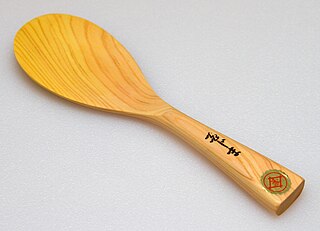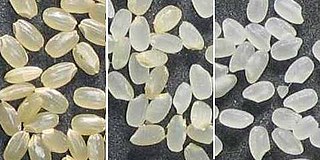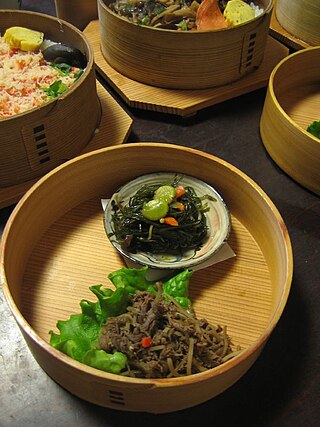Related Research Articles

Japanese cuisine encompasses the regional and traditional foods of Japan, which have developed through centuries of political, economic, and social changes. The traditional cuisine of Japan is based on rice with miso soup and other dishes; there is an emphasis on seasonal ingredients. Side dishes often consist of fish, pickled vegetables, and vegetables cooked in broth. Seafood is common, often grilled, but also served raw as sashimi or in sushi. Seafood and vegetables are also deep-fried in a light batter, as tempura. Apart from rice, a staple includes noodles, such as soba and udon. Japan also has many simmered dishes, such as fish products in broth called oden, or beef in sukiyaki and nikujaga.

Sushi is a Japanese dish of prepared vinegared rice, usually with some sugar and salt, plus a variety of ingredients, such as vegetables, and any meat, but most commonly seafood. Styles of sushi and its presentation vary widely, but the one key ingredient is "sushi rice", also referred to as shari (しゃり), or sumeshi (酢飯).

Mirin is a type of rice wine and a common ingredient in Japanese cooking. It is similar to sake but with a lower alcohol content and higher sugar content. The sugar content is a complex carbohydrate that forms naturally during the fermentation process; no sugars are added. The alcohol content is further lowered when the liquid is heated.

In Japanese cooking, a makisu (巻き簾) is a small mat woven from bamboo and cotton string that is used in food preparation. Makisu are most commonly used to make a kind of rolled sushi called makizushi (巻き寿司), commonly called maki. They are also used to shape other soft foods such as omelets, and to squeeze excess liquid out of food.

A shamoji or rice paddle is a large flat spoon used in East Asian cuisine. It is used to stir and to serve rice, and to mix vinegar into the rice for sushi.

Gimbap, also romanized as kimbap, is a Korean dish made from cooked rice, vegetables, fish, and meat rolled in gim—dried sheets of seaweed—and served in bite-sized slices. The origins of gimbap are debated. Some sources suggest it originates from Japanese norimaki, introduced during Japanese colonial rule, while others argue it is a modernized version of bossam from the Joseon era. The dish is often part of a packed meal, or dosirak, to be eaten at picnics and outdoor events, and can serve as a light lunch along with danmuji and kimchi. It is a popular takeaway food in South Korea and abroad and is known as a convenient food because of its portability.

The history of sushi began with paddy fields, where fish was fermented with vinegar, salt and rice, after which the rice was discarded. The earliest form of the dish, today referred to as narezushi, was created in Japan around the Yayoi period. In the Muromachi period (1336–1573), people began to eat the rice as well as the fish. During the Edo period (1603–1867), vinegar rather than fermented rice began to be used. The dish has become a form of food strongly associated with Japanese culture.

Japanese rice refers to a number of short-grain cultivars of Japonica rice including ordinary rice (uruchimai) and glutinous rice (mochigome).

Wappa meshi (わっぱ飯) is a Japanese dish cooked in special round containers made of thin wooden sheets. It is rice topped with other ingredients and is a specialty of the Niigata or Fukushima Prefecture.

Cooked rice refers to rice that has been cooked either by steaming or boiling. The terms steamed rice or boiled rice are also commonly used. Any variant of Asian rice, African rice or wild rice, glutinous or non-glutinous, long-, medium-, or short-grain, of any colour, can be used. Rice for cooking can be whole grain or milled.
An itamae is a cook in a Japanese kitchen or a chef of a large restaurant. The term can be translated literally as "in front of the board," referring to a cutting board.

The harvesting and consuming of seafoods are ancient practices that may date back to at least the Upper Paleolithic period which dates to between 50,000 and 10,000 years ago. Isotopic analysis of the skeletal remains of Tianyuan man, a 40,000-year-old modern human from eastern Asia, has shown that he regularly consumed freshwater fish. Archaeology features such as shell middens, discarded fish bones and cave paintings show that sea foods were important for survival and consumed in significant quantities. During this period, most people lived a hunter-gatherer lifestyle and were, of necessity, constantly on the move. However, where there are early examples of permanent settlements such as those at Lepenski Vir, they are almost always associated with fishing as a major source of food.

Japanese dining etiquette is a set of traditional perceptions governing specific expectations which outlines general standards of how one should behave and respond in various dining situations.

The sushi burrito or sushirrito is a type of Japanese-American fusion cuisine. It is typically prepared by rolling sushi ingredients such as fish and vegetables in a wrap and serving like a burrito. The dish is a form of American cuisine inspired by Japanese cuisine, but is not considered to be authentically Japanese.
References
- ↑ Nagano, Kuniaki; Sasaki, Kunihiko; Endo, Takashi (2013). "Breeding of new rice cultivar 'Tohoku 194' with 'Sasanishiki'-type good eating quality of cooked rice". Breeding Science. 63 (2): 233–237. doi:10.1270/jsbbs.63.233. PMC 3688386 . PMID 23853519.
